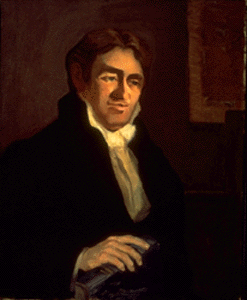Samuel Burtis Baker
Artist, Indiana Governors' Portrait Collection

William Hendricks (1782-1850)
Governor of Indiana
December 5, 1822-February 12, 1825
Artist: Samuel Burtis Baker, American, 1882-1967
oil on canvas, 32 3/16 x 26 5/16 (81.7 x 66.8)
Unsigned
GOVERNOR WILLIAM HENDRICKS had an aversion to posing for artists during his lifetime, hence the procurement of his portrait posed the greatest problem for Governor Baker. The effort proved the determination with which the citizens of Indiana met the task of completing the official collection.
The first portrait of William Hendricks was in the collection for a very short time. (1) It was painted by a New Castle, Kentucky, lawyer, R. H. Buckley, and associate of Hendricks who professed to have been a painter in his youth. Buckley offered to paint the portrait from memory with the aid of a photograph of the governor's brother, Jamison Hendricks, a memory sketch by the governor's son Grover, and verbal descriptions offered by William Hendricks's associates. Governor Baker was anxious to complete the project before his term expired, and, having exhausted all apparent possibilities, he commissioned Buckley to make the likeness. The painting was delivered in December, 1870, and was promptly removed from the collection three years later by Thomas A. Hendricks when he assumed office in 1873, on the grounds that the portrait was not a true likeness of his uncle.
For almost fifty years there was no portrait of William Hendricks in the collection, and there is nothing to show that any definite steps were taken by officials to find one. In 1919, an H. J. Gensler of the Official Reporters' Office, United States Senate, made the fortuitous discovery of a picture of William Hendricks in a painting of a group of eighty-six Congressmen. Gensler identified Hendricks as the seventh figure from the lower left corner in Samuel F. B. Morse's painting, The Old House of Representatives of 1822, in the collection of the Corcoran Gallery of Art, Washington, D.C.
Plans were made to get a photograph of the diminutive figure, so that a local painter could make an enlarged oil copy, but several problems arose. Each individual pictured in the Morse painting actually sat for his portrait, but the artist's primary concern was to faithfully represent the National Hall, (2) consequently the features of Hendricks were not well defined. Also, the poor condition of the painting at the time rendered the photograph of the figure useless.
After several unsuccessful attempts were made to engage an artist to copy the portrait directly for the sum of money authorized by the state legislature, the matter was dropped. In 1925, through the efforts of the Indiana Historical Bureau and Merrill Moores, representing the Seventh Indiana District in Congress, a Washington artist, Samuel Burtis Baker, was commissioned to make an enlarged replica of William Hendricks from the Morse painting.
Baker, a portrait painter, was at the time Vice Principal and Instructor at the Corcoran School of Art and Adjunct Professor of Painting at the George Washington University. Born in Boston, Baker studied there with Joseph De Camp and taught in Cambridge, Massachusetts, at the Rindge School before going to Washington. He was a prolific and successful portrait painter in Washington, where he died in 1967.
Baker approached the project with a dual concern: (3) to remain faithful to Morse's picture of Hendricks; to make the necessary changes in the interest of an accurate likeness. (4) Guided by Merrill Moores, Baker consulted descriptions of William Hendricks in books and sought the advice of William Henry Smith, an "old newspaper man" living in Washington, who had been a close associate of Hendricks. On the authority of the above sources, Baker changed the hair color from black to sandy and made the background grey to relieve the hair. The eyes have been opened and have been made blue. To improve the total construction, the ear has been raised in keeping with the tilt of the head. Finally, the clothes have been drawn in greater detail in accord with the styles of the day. Baker has cleverly footnoted his major source by using Merrill Moores's copy of Life and Public Services of Thomas A. Hendricks by Holcombe and Skinner as a model for the book in Hendricks's hand.
Stylistically, Baker has worked in a broad, direct manner. The generalized effect is appropriate since the portrait represents a synthesis of verbal reports and visual imagery, rather than a finished likeness.
(1) For a more detailed description of the events leading up to the acquisition of the Burtis Baker portrait of William Hendricks see the catalogue entry and footnotes for the portrait in Wilbur D. Peat, Portraits and Painters of the Governors of Indiana, 1944, pp. 397-400.
(2) The Corcoran Gallery of Art, Washington, D. C., A Catalogue of the Collection of American Paintings in the Corcoran Gallery of Art, Washington, D. C., Corcoran Gallery of Art, 1966, I, p. 53, illus. p. 52.
(3) The following discussion of Baker's approach to the Hendricks portrait was explained by Baker in a letter of May 24, 1926, from Samuel Burtis Baker to C. Coleman, Director of the Indiana Historical Bureau. Governors' portraits files, Indiana Historical Bureau.
(4) For descriptions of William Hendricks used by Burtis Baker, see William Wesley Woollen, Biographical and Historical Sketches of Early Indiana, Indianapolis, Hammond & Co., 1883, pp. 54-55; and John Walker Holcombe and Hubert M. Skinner, Life and Public Services of Thomas A. Hendricks with Selected Speeches and Writings, Indianapolis, Carlon & Hollenbeck, 1886, p. 19.
Source: Peat, Wilbur D. Portraits and Painters of the Governors of Indiana 1800-1978. Revised, edited and with new entries by Diane Gail Lazarus, Indianapolis Museum of Art. Biographies of the governors by Lana Ruegamer, Indiana Historical Society. Indianapolis: Indiana Historical Society and Indianapolis Museum of Art, 1978.
